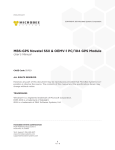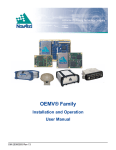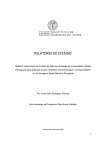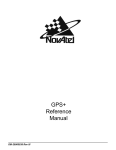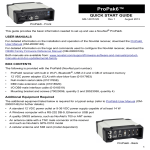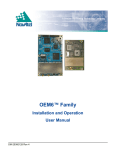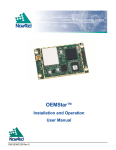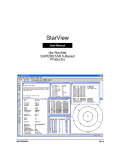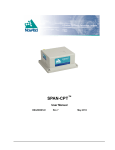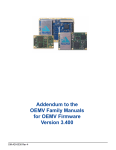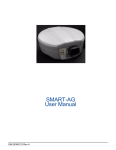Download GM-14915062 Rev 5 Vcards QSG.fm
Transcript
OEMV-1, OEMV-1G, OEMV-2 or OEMV-3 Card QUICK START GUIDE This guide provides the basic information you need to set up and begin using your new OEMV family card. For more information on the installation and operation of your receiver, please refer to the OEMV Family User Manuals on the CD provided. The technical specifications of the OEMV family of cards are contained there also. To order a printed copy of the manuals, free of charge, follow the instructions given on the enclosed User Manuals postcard. The most up to date revisions of these manuals can be found on our website at http://www.novatel.com/Downloads/docupdates.html. • • • • • An enclosure to protect against environmental conditions and RF interference A wiring harness, see Figure 2, to provide power to the receiver and access to the data and strobe signals, with one or more DB-9 connectors for serial communication with a PC or other data communications equipment A null-modem cable, see Figure 3 for an example A quality GNSS antenna, such as our GPS-702 (L1/L2), 702GG (plus Glonass) or 702L (plus L-Band), see Figure 4 for an example An antenna cable with a male MCX (OEMV-1) or MMCX (OEMV-2 and OEMV-3) connector at the receiver end, see Figure 5 for an example. • 3 4 OEMV-2 • Figure 3: User-Supplied Null-Modem Cable Example OEMV-1 3 and OEMV-1G 1. Install the OEMV family card and the wiring harness in a secure enclosure to reduce environmental exposure and RF interference, making sure to protect against ESD. CAUTION: If you do not take the necessary precautions against Electrostatic Discharge (ESD), including using the provided ESD wrist strap, you may damage the OEMV card and void your warranty. 2 2 3. Mount a GNSS antenna on a secure, stable structure with an unobstructed view of the sky. 4. Connect the GNSS antenna to the OEMV family card using a coaxial cable. 5. Connect a serial port on the receiver to a serial port on the PC, or other computing device, using a null modem cable. 1 ESD wrist strap 1 OEMV Family Quick Reference Guide 1 postcard for requesting printed user manuals A Windows-based computing device with a RS-232 DB9 or USB port A power supply between 4.5 and 18 VDC for the OEMV-3 card, and 3.3 VDC for the OEMV-1, OEMV1G and OEMV-2 cards, capable of providing at least 5W Complete the steps below to connect and power your OEMV family card. See the OEMV Family Installation and Operation User Manual for more information on steps 2 through 5. 2. Reconfigure the ports if necessary. COM1 on the OEMV-1 and OEMV-1G cards are configured in LVTLL mode while COM1 on the OEMV-2 and OEMV-3 cards are configured in RS-232 mode by default. COM1 on the OEMV-3 can be reconfigured to RS-422 or LVTTL using jumpers. OEMV-3 In addition to this Quick Start Guide, the following is provided with your OEMV family card: The additional equipment listed below is required for a basic setup: Figure 2: User-Supplied Wiring Harness Example 3 4 BOX CONTENTS ADDITIONAL EQUIPMENT REQUIRED (+) SETTING UP YOUR OEMV FAMILY CARD Figure 1 shows the cards, their connectors and indicators. Also on the CD are an installation program for NovAtel’s PC utilities including CDU (Control and Display Unit), the OEMV Software Development Kit including OEMV Sample Source Code and Universal Serial Bus (USB) drivers with their installation instructions. • • • To create a common ground, tie together all digital grounds (GND) with the ground of the power supply. 6. Connect a power supply to the OEMV family card. Figure 4: User-Supplied Antenna (702 Example Shown) 5 Ref. # 1 2 3 4 5 1 1 1 2 Description Power/data/signal connector (OEMV-1:20; V-2:24; V-3:40-pin) LED status indicator RF signal in/LNA power out (OEMV-1: MCX;V-2/V-3: MMCX) External oscillator input (MMCX) CAN bus connector with transceiver Figure 1: Connector and Indicator Locations Figure 5: User-Supplied MMCX to TNC Cable Example 7. Plug in and/or turn on the power supply. INSTALLING THE PC UTILITIES ESTABLISHING RECEIVER COMMUNICATION Once the OEMV card is connected to the PC, antenna, and power supply, install NovAtel’s PC Utilities. To open communication with the receiver, follow these steps. 1. Start up the PC. 2. Insert the OEMV CD, see Figure 6, in the CD-ROM drive of the computer. 4. Enter a name for the new device configuration in the Name field of the New Config dialog box and select the Settings button. 1. Launch CDU from the Start menu folder specified during the installation process. The default location is Start | Programs | NovAtel OEMV | OEMV PC Software. 11. Select the Open button to open communications with the OEMV card. 2. Select Open.... from the Device menu. 3. Select Install the OEMV PC Utilities from the window that is automatically displayed. If the window does not automatically open when the CD is inserted, select Run from the Start menu and then the Browse button to locate Setup.exe on the CD drive. As CDU establishes a communication session with the receiver, it displays a progress box. Once CDU is connected, the progress box disappears and several windows open, including the Console window. CDU is now ready to be used to view status information, enter commands, or log data. 4. Install the PC Utilities by advancing through the steps provided in the NovAtel PC Utilities setup program. 3. Select the New... button in the Open dialog box. USING CDU 5. Select the PC serial port the OEMV card is connected to from the PC Port drop-down list. 6. Select 57600 from the Baud Rate list. 7. Uncheck the Use hardware handshaking checkbox. 8. Select OK to save the settings. Figure 6: OEMV CD Example 10. Select the new configuration from the Available device configs list in the Open dialog box. 9. Select the OK button to close the New Config dialog box and create the new device configuration. CDU provides access to key information about your receiver and its position. The information is displayed in windows accessed from the View menu. For example, select Position Window from the View menu to display the position solution of the receiver. To show details of the GNSS and geostationary (SBAS) satellites being tracked, select a Tracking Status Window (GPS or GLONASS) from the View menu. Select Help from the main menu for more details on CDU, its windows and features. DETERMINING WHEN THE POSITION IS VALID LOGGING DATA ENABLING SBAS ENABLING L-BAND (OEMV-1 and OEMV-3 only) When the receiver has a valid position, the POSITION VALID or PV signal pin of the DIN connector changes to a logic level high (LVTTL). In addition, the Solution Status field in CDU’s Position window shows Computed. An extensive collection of logs has been created to capture the data your OEMV family card receives and processes. These logs can be directed to any of the OEMV family card’s serial ports and can be automatically generated when new or changed data becomes available or at regular intervals. The available logs are listed in the OEMV Family Quick Reference Guide. All models of OEMV family cards are capable of SBAS positioning. This positioning mode is enabled using the SBASCONTROL command. These commands are typically used to enable WAAS (North America) and EGNOS (Europe) respectively: L-Band equipped receivers allow you to achieve sub-meter accuracy. To use this positioning mode, you must enable L-band tracking to the Canada-Wide Differential GPS (CDGPS) or OmniSTAR signal. A subscription to OmniSTAR is required to use the OmniSTAR VBS, XP or HP service (visit http:// www.omnistar.com with your receiver serial number ready). The CDGPS signal is free and available without subscription over North America (visit http://www.cdgps.com). ENTERING COMMANDS The OEMV family cards use a comprehensive command interface. Commands can be sent to the receiver using the Console window in CDU, which is opened from the View menu. Enter commands in the text box at the bottom of the Console window. The following information is important when entering commands: • Commands can be entered in three formats: ASCII (log bestposa), Abbreviated ASCII (log bestpos), and Binary (log bestposb). Abbreviated ASCII is the best format to use when you wish to work with the receiver directly. For data collection, use ASCII or Binary. • Press the Enter key to send the command string to the receiver. • The commands are not case sensitive. The OEMV Family Quick Reference Guide provided with the receiver lists the available commands and the parameters they use for the Abbreviated ASCII format. To log data, use the LOG command. For example, to log the pseudorange position to COM 2 every 30 seconds, enter the following: LOG COM2 PSRPOS ONTIME 30 Logs can be generated in one of three formats: ASCII, Abbreviated ASCII, or Binary. Refer to the OEMV Family Firmware Reference Manual (OM-20000094) for information on the LOG command, specifying the output format, and the detailed contents of each log. If you prefer, CDU provides a graphical interface for configuring data logging. Select Logging Control Window from the Tools menu. In the Logging Control window, you can select which logs to capture and choose to which ports to send the data. In addition, you can specify a file in which to save the data. SBASCONTROL ENABLE WAAS SBASCONTROL ENABLE EGNOS Once enabled, the Position Type field shown in CDU’s Position window should change from Single to WAAS and you may see SBAS satellites in the Constellation window. The ASSIGNLBAND command allows you to set OmniSTAR or CDGPS base station communication parameters. It should include a relevant frequency and data rate. The frequency assignment can be made in Hz or KHz. For example: Hz: KHz: assignlband omnistar 1536782000 1200 assignlband omnistar 1536782 1200 A value entered in Hz is rounded to the nearest 500 Hz. To confirm you are tracking an L-Band signal, log the L-Band status information by entering: log lbandstat. For example, if you are receiving CDGPS, the fifth field after the header should be 00c2: lbandstata com1 0 43.5 finesteering 1295 149951.671 00000000 976f 34461; 1547546977 46.18 4541.0 0.00 00c2 00f0 ... To specify the correction source, use the PSRDIFFSOURCE command as shown in the examples below: PSRDIFFSOURCE OMNISSTAR or, PSRDIFFSOURCE CDGPS otherwise it is left at the default AUTOMATIC. Refer to the OEMV Family Firmware Reference Manual for more on individual L-Band, GLONASS or SBAS commands and logs. REAL-TIME KINEMATIC (RTK) POSITIONING Corrections can be transmitted from a base station to a rover station to improve position accuracy. The base station is the GNSS receiver which is acting as the stationary reference. It has a known position and transmits correction messages to the rover station. The rover station is the GNSS receiver which does not know its exact position and can receive correction messages from a base station to calculate differential GNSS positions. In most cases you need to provide a data link between the base station and rover station (two NovAtel receivers) in order to receive corrections. SBAS and L-Band corrections can be accomplished with one receiver and are exceptions to the base/ rover concept. Generally a link capable of data throughput at a rate of 9600 bits per second, and less than 4.0 s latency, is recommended. Once your base and rover are set up, you can configure them for RTCA, RTCM, RTCMV3, CMR+ or CMR corrections. Below is an RTCM example (replace the latitude, longitude and height coordinates shown with those of your base): Base interfacemode com2 none rtcm off fix position 51.11358042 -114.04358013 1059.4105 log com2 rtcm3 ontime 10 log com2 rtcm22 ontime 10 1 log com2 rtcm1819 ontime 1 log com2 rtcm1 ontime 5 Rover interfacemode com2 rtcm none off RT-2 (OEMV-2 and OEMV-3) and RT-20 (OEMV-1, OEMV-1G, OEMV-2 and OMEV-3), all with AdVance RTK, are real-time kinematic software products developed by NovAtel. Optimal RTK performance is achieved when both the base and rovers are NovAtel products. However, AdVance RTK will operate with equipment from other manufacturers when using RTCM messaging. RT-2 and RT-20 are supported by GPS-only and GPS+GLONASS OEMV-based models. Also, RT-20 with GPS+GLONASS provides faster convergence. 1. Refer to the GPGST log’s usage box in the OEMV Firmware Reference Manual for a definition of RMS and other statistics. 2. For more base/rover configurations, search the key words “rover base” on our Knowledge Database at: http://www.novatel.com/support/knowledgedb.htm USING THE CAN BUS A CAN Bus is a serial bus that provides services for processes, data and network management. On OEMV-1/1G cards, the CAN port is shared with the EVENT2 input and VARF output. On the OEMV-2 cards, CAN pins are shared with Event2 input and the GPIO signal. They require external CAN transceivers and proper bus terminations. The OEMV-3 has two CAN transceivers, CAN1and CAN2. Proper bus termination is required. CAN Bus functionality is controlled through NovAtel’s optional API software available through Customer Service. The API header file (*.h), in the API folder after installation, includes documentation on using the CAN Bus. EXTERNAL OSCILLATOR (OEMV-2 and OEMV-3 only) For certain applications requiring greater precision than what is possible using the on-board 20 MHz, voltage-controlled, temperature-compensated crystal oscillator (VCTCXO), you may wish to connect the OEMV card to an external, high-stability oscillator. The external oscillator can be either 5 MHz or 10 MHz. QUESTIONS OR COMMENTS To install, connect a cable from the external oscillator to the card’s external oscillator input. The receiver does not have to be powered down during this procedure. If you are handling the OEMV card directly, antistatic practices must be observed. If you have any questions or comments regarding your OEMV card, please contact NovAtel using one of these methods: Once the external oscillator has been installed, issue the EXTERNALCLOCK command to define the clock model (for example, cesium, rubidium or ovenized crystal). If the input clock rate is 5 MHz, you must issue the EXTERNALCLOCK command to change the 10 MHz default rate. Web: Email: [email protected] www.novatel.com Phone: 1-800-NOVATEL (U.S. & Canada) 403-295-4900 (International) Fax: 403-295-4901 POST PROCESSING Post-mission data processing refers to when the GNSS data collected by the receiver is processed after the entire datacollection session is complete. OEMV-based output is compatible with post-processing software from the Waypoint Products Group, NovAtel Inc. For details, visit our website at: http://www.novatel.com/products/waypoint_pps.htm OEMV Family Cards: Quick Start Guide: © Copyright 2006-2007 NovAtel Inc. All rights reserved. Printed in Canada on recycled paper. Recyclable. Unpublished rights reserved under international copyright laws. GM-14915062 Rev 5 2007/06/26









